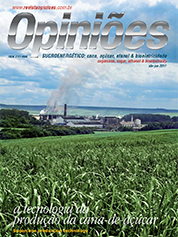Jaime José Stupiello
Agricultural Director at Açúcar Guarani - Tereos Group
Op-AA-28
Mechanical planting: a system
Since 1992, Guarani has experimented with the mechanical planting system, actually having designed, manufactured, and during four years, operated its own prototype. Following a trip to Australia, in 1999, we came back convinced that mechanical planting would be the best solution.
At the time, equipment suppliers showed little interest in the system, obliging us to implement the performance improvements we were developing. Nowadays, 50% of Guarani’s planting area is planted using mechanical planting, and our goal is to reach 90% by the 2015 harvest.
The mechanical sugarcane planting system is being perfected each year and the sugar and ethanol industry’s economic and social scenario is such that there is no way back, due to the significant reduction in cost of the mechanical option, along with the relevant gains in operational efficiency.
All phases of the planting system can be mechanized, including furrowing, fertilizing, distributing seed cane, and covering furrows, while simultaneously applying pesticide and fungicide. Mechanical planting in fact begins with harvesting seed cane in the nursery. This operation must be performed by a harvester equipped with accessories that preserve bud quality.
The same care must be taken in transporting sugarcane to the planting area and in supplying to the planters. Care taken in harvesting seed cane, so as to protect the buds, reduces damage by up to 50%. Mechanical planting must be viewed as a system rather than an activity: lack of attention to this requirement was one of the main reasons for unsuccess in the past.
One must also point out that there are limitations to the use of mechanical cutting of some varieties of seed cane, due to its susceptibility to damage, as is the case of genetic material with salient buds. Lack of labor is one of the main reasons indicating that mechanical planting tends to increase in coming years.
Mechanical planting reduces the need for labor by up to 80%, directly reflecting in the operation’s end cost. Considering only operational costs and no earlier costs – of cutting, loading and transporting seed cane to the planting area – one sees that mechanical planting is highly advantageous. However, the highest costs in the mechanical system occur in operations involving seedling cutting.
Depending on the distance to the planting area, such costs can exceed those of manual planting, mainly because of higher consumption of seed cane per hectare – which until now was not possible to reduce. Since its introduction, mechanical planting has had lower costs in comparison with manual planting.
Over the years, this advantage increased, mainly due to the increase of labor costs that, on average, went up by about 20% per year, in the last ten years. Some factors must be taken into consideration to be successful in this kind of planting, such as: planning and organizing plots, planning the nursery and setting seed cane’s age, preparing equipment, the support structure and training the workforce.
Among mechanical planting’s main challenges are the dosage of billets and their distribution in the furrows, planting at the end of the line, damaging buds and billets, and controlling operations. The three most important topics are:
1. Well trained and committed operators, because they are who distribute cane in the furrows;
2. Selecting seed cane;
3. Cutting seed cane – nowadays, this is done using the same harvester (with a few modifications) used in harvesting, while still being far from ideal.
Another issue to highlight refers to the short time available for planting – concentrated in the months of February to May, usually rainy months. This unsatisfactory performance results from the fact that equipment is heavy, both for harvesting and planting seed cane. In 2011, this aspect stood out, with operations very adversely affected due to excessive rain, mainly in March.
New technology developed by Syngenta, called Plene, might, in my viewpoint, contribute to eliminate or minimize some of the mentioned limitations. This is technology that still entails doubts and requires adjusting, but expectations are highly optimistic, in the sense that there is a huge benefit, making the industry euphoric and confident.
The industry has an alternative to planters: the so-called cane distributors: This equipment does not perform the furrowing and covering of billets, but only distributes them in the furrows. The disadvantage lies in the need to use other equipment for such operations, but even so, at less cost than manual planting, mainly because of the reduction in labor.
The big advantage in comparison with mechanical planting is the possibility to evaluate buds in the furrows, before covering them. The Guarani Group is using such distributor equipment.
In light of this scenario, one can confirm the need to quickly migrate to mechanical planting, to the extent of almost 100% of the area. The concern that remains is whether all issues and adjustments that need to be addressed, in all phases of mechanical planting, will be solved shortly, so that one will not have to pay high costs due to such slow correcting.




